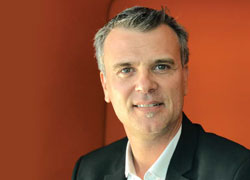Tom Rebbeck, research director at Analysys Mason caught up with Nicolas Chalvin, the vice president of enterprise IoT ecosystem marketing at Gemalto, to discuss Gemalto’s approach to the smart city.
Tom Rebbeck: What is Gemalto’s strategy for smart cities?
Nicolas Chalvin: To understand Gemalto’s strategy for smart cities, you must first understand what Gemalto does more generally.
Gemalto is the global leader in digital security with customers in more than 180 countries. We bring trust to an increasingly connected world and our technologies and services enable businesses and governments to authenticate identities and protect data. We work with customers across a wide variety of vertical markets including government, banking, telecoms, enterprise and IoT and new mobility for the automotive markets. For each of these sectors, we authenticate people, transactions, applications and objects, encrypt data and enable digital transformation that allows our clients to deliver secure digital services for billions of individuals and things. Gemalto’s solutions are truly at the heart of modern life.
For the IoT, our goal is to help our customers connect, secure and monetise their IoT solutions. Our products, software solutions and services enable connectivity and security and bring trust to the end-to-end ecosystem. To accomplish this, we must protect data on the device, data in motion and data stored in the cloud, and we must ensure that only authorised people are able to access this data. This is the main concept for security in IoT.
To talk more specifically about smart cities, it is an ecosystem where we are engaged in all types of use cases – transport, health and energy – and it is incredibly complex. Because of the many different use cases, we face diverse types of connectivity requirements, a variety of actors and stakeholders, different security needs, different data, servers and so on.
Gemalto’s strategy for the smart city is to be able to simplify the complex ecosystem by providing security for all participants and all types of connectivity to enable trust. Because, for smart cities, the main goal is for all of the actors to trust the ecosystem.
TR: Picking up on the diversity of devices, networks and applications. Where do you fit in? Who are you selling to?
NC: Within Gemalto we really want to have an end-to-end approach – from the device to the server. We provide connectivity and security solutions to device makers. For example, we deliver cellular modules including: 2G, 3G, 4G, IoT-optimised LTE Cat 1 and LTE-M, as well as NB-IoT in the near future. We also deliver secure elements that are embedded into devices adding an extra layer of tamperresistant protection. In addition we work with mobile network operators (MNOs), for example, where we deliver SIMs and eSIMs as well as services for lifecycle management, ondemand connectivity and quality of service. We also work to secure new low power wide area (LPWA) connectivity networks such as LoRa, and we’re a member of the LoRa Alliance.
We deliver solutions to ensure authorisation or access authorisation management of data across the ecosystem as well.

TR: Can you talk about that further? Smart cities generate data from various sources and you want to share some of that data, but also control who has access to what. Can you explain what you are doing and how that works?
NC: Yes, a few years ago, we acquired a company called Safenet, adding cloud security, access management and software monetisation to our product offerings. To achieve this, we offer a basic solution called an HSM – hardware security module – which is able to secure the cloud and also data on the fly. In addition, we also offer a solution called RBA – risk based authentication – where we can define some rules and control who can and cannot access the data.
TR: In terms of how you position yourself? Who do you compete against and what are your differentiators?
NC: We have classic competitors for each element of what we offer – connectivity, security, monetisation, payments and more. For instance for cellular connectivity, we compete with other companies that provide modules. However, we are the only connectivity module provider that offers world leading digital security expertise. Our customers therefore benefit from Gemalto’s unique position on security, including encryption and ID management as well as our deep transversal knowledge ranging from banking and government to telecoms and enterprise solutions.
When we look at the smart cities space, it is a highly fragmented market with many suppliers offering different components of smart city solutions. A smart city solution developer or integrator will work with dozens of different suppliers to create just one aspect of their solution. But with Gemalto, smart city developers can have one provider that offers an end-to-end solution for connectivity, security and monetisation – three essential elements crucial to success.
We support smart city integrators delivering a solid foundation of connectivity, security and monetisation, which is the basic foundation of any smart city project. Integrating these elements into smart cities is something only integrators can do.
TR: Do you have preferred integrator partners or do you work with all of them?
NC: No, Gemalto is working with all of them – we are committed to doing all we can to simplify and accelerate development and bring value to all integrators and developers.
TR: Can you give some examples of cities where your solutions have been implemented? What has been implemented?
NC: The key smart city projects are still at the beginning. In the Middle East, we are providing solutions for roads and transportation, as well as for digital ID and mobile payments. In the US, we are also involved in governmental projects in the digitalisation of ID and driving licences, which is also the start of smart cites. We are discussing projects with energy providers in Germany about smart metering solutions – it is not a complete smart city but it is part of a solution that can be bundled together to bring a real smart city solution.
TR: They are interesting examples as they cut across the different vertical markets involved in smart cities that you mentioned earlier – transport, payments and ID, energy
NC: Another example is a demo we did at MWC 2017 with a lighting company. It provides streetlights that are also charging stations for electric cars and serve as a platform for smart city services. In addition to providing secure connectivity to the smartlight solution, we can also deliver security to the vehicle charger and manage the ID of the car and the driver as well as providing a secure payment solution for power consumption. It’s something only Gemalto can do.










